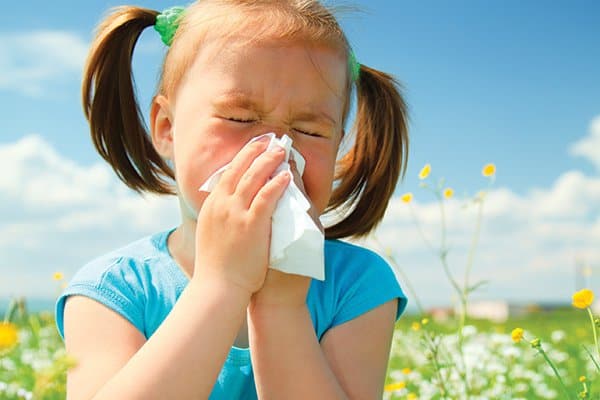Spring is in the house! It's brought sunshine and flowers but in the UK, it can still be windy and chilly, when the Sun is out. The change in weather make it a sensitive time for children's health and their allergies.
These are a list of common allergies your child can suffer from in spring:
1. Nasal Allergies
The most common manifestation of allergies are: Nasal congestion, itchy and runny nose, itchy throat, excessive sneezing, persistent cough, often rattling, etc.
These are some symptoms of the allergies like a crease across the top of the nose from constant wiping and sniffling, dark circles under eyes, post-nasal drip
If you really want to know whether your child is suffering from allergies or just a cold, you are going to have to wait and see if symptoms persist longer than one to three months. This is perhaps the single most important indicator of allergies.
2. Seasonal Allergies and Pollen

If you suspect that your child has seasonal allergies due to pollen, here are the steps you can take to minimize exposure:
– Stay indoors on windy days during the pollen season, local weather websites usually have pollen count information.
– Pollen counts are usually highest during the late mornings and early afternoons. Limit outside playtime to early morning, late afternoon and evenings during allergy season.
– Don’t allow your child to play in fields with flowers and tall grass.
– Keep all the windows and doors closed during the pollen season.
– Keep car windows rolled up while driving.
– Wash hats and jackets more frequently during pollen season.
– Give your child a bath and wash hair before bedtime to get the pollen out.
– Don’t hang-dry your child(ren)’s laundry outside.
– Install a special filter into your central heating and cooling system.
– Put window air conditioning units on recirculate to keep out the outside air.
– Keep trees and bushes near the house well pruned to avoid heavy vegetation.
3. Allergic Conjunctivitis (red eyes)
How would you tell if it’s allergies or an infection?
– Bacteria: when the eyes are red with yellow or green drainage oozing or crusting in the eye throughout the day and night, then bacteria are usually the culprit. The eyelids may also be swollen. Affects one or both eyes.
– Virus: when the eyes are very red, but there is no drainage or only a small amount of drainage or crusting upon waking up, then it is probably viral conjunctivitis. Usually affects both eyes.
– Allergy: allergic conjunctivitis is usually seasonal, mostly in the spring. The eyes are usually red with increased tears, perhaps a small amount of white drainage, and unusually itchy. Usually affects both eyes.
– Foreign body – a piece of sand or dirt stuck under the eyelid can cause redness, tearing, pain and drainage. Usually affects one eye.
4. Sinus Infections
It usually takes around 10 days of sinus allergy symptoms for the bacteria to build up enough, for a sinus infection to occur. Sinus infections rarely just occur out of the blue.
Signs of a sinus infection include:
– Green nasal discharge for more than 10 days.
– Sinus headaches: pain or severe pressure behind and around the eyes, forehead, and upper cheeks can be a sign of sinus infection.
– Tooth pain: pain in the upper teeth or gums can indicate a sinus infection since the sinuses are right above this area.
– Green discharge from the eyes: eye drainage accompanied with all these other symptoms can mean sinus infection.
– Cough: A cough will almost always be present during a sinus infection. If your child does not have a cough, then it is less likely to be a sinus infection.
– Fever: infants and young children will usually have a fever during a sinus infection. Children older than 6 and adults may not have a fever. Remember, fever can be normal for up to five days during a cold.
– Fatigue – older children and adults will usually feel very worn out during a sinus infection. This fatigue can be part of a normal cold as well, but if it persists or is extreme, it could be the sinuses.
If your child has the first symptom above (green nasal discharge for more than 10 days), plus three or more of the remaining five symptoms, than it may be a sinus infection. Consult your doctor. If, on the other hand, you only have one or two symptoms, especially if there is no green discharge from the nose, then an infection is less likely.
5. Allergic Asthma
Those whose asthma has more of an allergic trigger may suffer flare-ups during the spring allergy season.
If your child begins to experience more frequent chest tightness, wheezing, nighttime coughing or decreased exercise tolerance during these months, you should talk to your doctor, about using a preventative inhaler and/or allergy medication to make the season easier.
Remember, such medications can be stopped, with your doctor’s advice, come summertime if your child is doing well.
6. Gastroenteritis

If you or your child shows signs of vomiting, diarrhea, or sharp stomach pains, be sure to cut fatty and sugary foods out of your diet for the time being. Stick to the (BRAT) diet, which helps reduce irritation in your stomach while controlling your troublesome symptoms of gastroenteritis, too.
As with any other contagious virus, remember to incorporate proper hand-washing and sanitation guidelines into your everyday routine. Have a disinfectant on hand and keep your family’s immune system healthy with vitamin-rich and nutritional meals.
7. The Common Cold
The common cold is, well, common. This means that, unfortunately, even the blossoming and sunnier environments of springtime see their fair share of sniffles and coughing, too.
Safeguard your home against the common cold by washing your hands often — especially in public spaces.
Advise your children to avoid touching their mouth, eyes, and nose, too. Try incorporating an immune support routine into your daily regime to keep your health in optimal shape as well.
8. Strep Throat
If you’re unsure whether you or someone in your family has a simple cold or strep throat, doctors recommend you ask yourself two fundamental questions to differentiate the two. First, do you have a cough? Secondly, do you have a fever?
It’s essential to know that temperatures are a standard side effect of strep throat, while coughs are not. After you distinguish what type of illness is bothering you, it’s easier to find the right treatment plan to rejuvenate your health with ease.
Strep throat spreads easily through coughing, sneezing, and touching objects that may contain the saliva of an infected individual, be sure to keep disinfectant wipes and hand sanitizer with you within your home.
9. The Flu

Spring puts you at risk of contracting the flu because this virus responds well to humidity — a condition which unfortunately becomes common during the spring. The temperatures begin to rise, but the coughing, body aches, and fevers remain steady.
To protect your family against this virus, remember to incorporate healthy proteins, fibers, and vitamins into your everyday eating routine. The best preventative to take against contracting this unwanted illness is to ensure your family gets vaccinated every year, too.
A simple shot and a few preventative measures can ward off countless days spent laying on the couch, so you can get up and go while enjoying the fresh spring air instead.
Sources: AskDrSears and Mommybite
What is the most common illness your child would usually suffer from during this time of the year and what are your tips to avoid that?
Above are our suggestions on the symptoms but remember to always consult your doctor before making any assumptions about the allergies.
Further information
Book or message SafehausUK directly from our website http://safehaus-uk.co.uk/ for more information about our professional childcare service.

